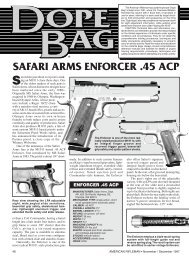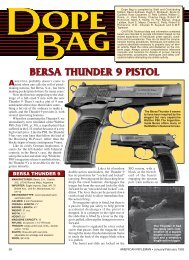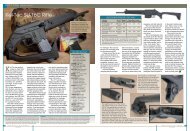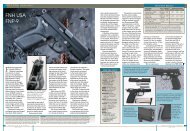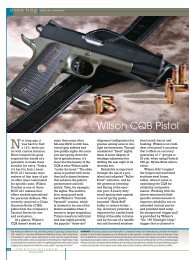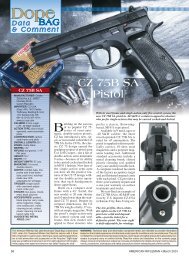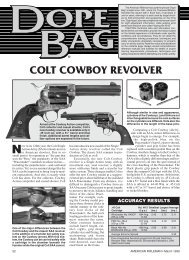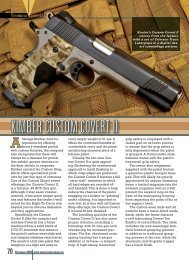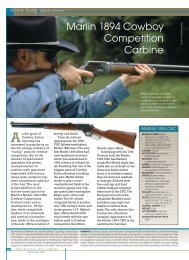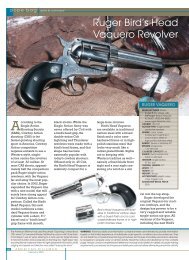IN
Download AR Dope Bag Jan. 1996 - The National Firearms Museum
Download AR Dope Bag Jan. 1996 - The National Firearms Museum
- No tags were found...
Create successful ePaper yourself
Turn your PDF publications into a flip-book with our unique Google optimized e-Paper software.
®<br />
Dope Bag is compiled by Staff and<br />
Contributing Editors: David Andrews, Hugh<br />
C. Birnbaum, Bruce N. Canfield, Russ<br />
Carpenter, O. Reid Coffield, William C. Davis,<br />
Jr., Pete Dickey, Charles Fagg, Robert W.<br />
Hunnicutt, Mark A. Keefe, IV, Angus<br />
Laidlaw, Scott E. Mayer, Charles E. Petty,<br />
Robert B. Pomeranz, O.D., Jim Supica,<br />
Charles R. Suydam, A.W.F. Taylerson and<br />
Stanton L. Wormley, Jr.<br />
CAUTION: Technical data and information<br />
contained herein are intended to provide<br />
information based on the limited experience<br />
of individuals under specific conditions<br />
and circumstances. They do not detail<br />
the comprehensive training procedures,<br />
techniques and safety precautions<br />
absolutely necessary to properly carry on<br />
<strong>IN</strong> recent years, guns featuring various<br />
types of porting or compensation have<br />
dominated in many of the “practical”<br />
pistol sports. Due perhaps to the success<br />
of such guns, as well as to such well-established<br />
systems as Mag-Na-Port and, more<br />
recently, the Schuemann Hybrid system,<br />
barrel porting has become an increasingly<br />
common option on hunting and even<br />
carry guns. Rossi’s .357 Mag. 971<br />
VRC is a new offering in this latter<br />
category.<br />
The 971 VRC (which stands for<br />
Vent Rib Compensated) is a ported<br />
version of its 971 model,<br />
which, like all the Rossi<br />
revolver line, is based on the<br />
proven Smith & Wesson<br />
design. Heat-treated 400-<br />
series stainless steel is used<br />
for all major components.<br />
The barrel and frame are<br />
forged, while the cylinder<br />
is mach-ined from<br />
bar stock. The 971 VRC<br />
offers button-rifled,<br />
ported, fully-shrouded<br />
barrels in 2 1 ⁄2", 4", and 6"<br />
lengths. Our sample’s barrel was<br />
nominally 2 1 ⁄2", but measured 2.6".<br />
ROSSI MODEL 971<br />
MANUFACTURER: Amadeo Rossi, S.A.,<br />
Rua Amadeo Rossi 143, Sao<br />
Leopoldo, RS,Brazil<br />
IMPORTER: Interarms, Dept. AR, 10<br />
Prince St., Alexandria VA 22314<br />
MECHANISM TYPE: double-action<br />
revolver<br />
CALIBER: .357 Mag.<br />
OVERALL LENGTH: 7 1 ⁄2"<br />
BARREL LENGTH: 2 5 ⁄8"<br />
WEIGHT: 31 ozs.<br />
WIDTH: 1 1 ⁄2"<br />
HEIGHT: 5 1 ⁄2"<br />
CYL<strong>IN</strong>DER CAPACITY: 6<br />
TRIGGER: single-action pull, 3 1 ⁄4 lbs.,<br />
double-action, 11 1 ⁄4 lbs.<br />
SIGHTS: ramped post front with red<br />
insert; rear adjustable for windage<br />
and elevation<br />
PRICE: $375<br />
In size and appearance the Rossi closely<br />
resembles the Smith & Wesson K-<br />
frame design, though its grips conceal<br />
a J-frame-size butt and coil mainspring.<br />
In both size and appearance the 971<br />
VRC mirrors the S&W K-frame revolver<br />
family, though the Brazilian offering displays<br />
some subtle styling differences. The<br />
most salient distinguishing feature of the<br />
971 VRC is its massive 1/2"-wide rib with<br />
its bilateral scalloped relief cuts for the<br />
gases escaping from the barrel’s eight<br />
.125"-diameter ports.<br />
The Rossi’s internal lockwork<br />
offers no surprises to anyone<br />
familiar with the Smith & Wesson<br />
design. Though its frame approximates<br />
K-frame dimensions, its<br />
butt is actually J-frame size. The<br />
Rossi also uses a J-frame-type coil<br />
mainspring instead of the familiar<br />
flat spring.<br />
The 971 VRC features the<br />
Even with the reduction in recoil<br />
afforded by its heft and gas ports,<br />
a two-hand hold is still recommended<br />
when firing full-power<br />
.357 Mag. loads out of the Rossi.<br />
same adjustable-sight system<br />
found on other Rossi revolvers. In<br />
front, there is a blued-steel, ramped,<br />
serrated post .125" wide and .220" high,<br />
with a dovetailed red plastic insert. This<br />
is retained in the rib by a single crosspin.<br />
The adjustable rear sight is a close copy<br />
of the click-adjustable Smith & Wesson<br />
unit, but with a stainless steel body. Only<br />
50 AMERICAN RIFLEMAN • January 1996
the blade is blued, and that features a<br />
.140"-wide notch outlined in white.<br />
The 971 VRC’s porting pattern (which<br />
was designed by Roy Melcher of<br />
Interarms, the exclusive importer of the<br />
Rossi line) is more complex than simply<br />
drilling eight holes in the barrel. A small<br />
expansion chamber was created by counterboring<br />
the barrel to a diameter of about<br />
.475", starting about .250" back of the<br />
muzzle and extending rearward for another<br />
.82". Thus, the rifled portion of the barrel<br />
ends a full 1.070" back of the muzzle,<br />
giving a little over 1 1 ⁄2" of rifling. The collar<br />
created at the muzzle by the barrel<br />
sharp edges left around the front of the<br />
ejector rod shroud, barrel rib, and frame,<br />
as well as on the rear sight and rear edge<br />
of the cylinder. Sharp edges on a carry gun<br />
are not only hard on hands, holsters and<br />
clothing; they can also cause the gun to<br />
snag during presentation—a potentially<br />
fatal flaw.<br />
The Rossi’s 11 1 ⁄4-lb. double-action<br />
trigger pull was smooth and consistent<br />
throughout, with no stacking or hesitation,<br />
and was judged to be at least as good as<br />
that of other American-made guns in its<br />
class. Trigger return was also<br />
smooth and dependable, and<br />
seemed to be just right for fast,<br />
controllable double-action<br />
shooting. The single-action<br />
pull, as expected, was crisp<br />
and light, breaking at 3 1 ⁄4 lbs.<br />
We shot the 971 VRC for<br />
accuracy with results in the<br />
accompanying table, and<br />
function-fired it with Remington,<br />
Hornady, Samson,<br />
Black Hills, Winchester,<br />
Federal and CCI .357 Mag.<br />
ammunition. No malfunctions<br />
of any kind occurred during our testing.<br />
The 971 VRC’s accuracy level, though<br />
adequate for close-range self-defense purposes,<br />
was not quite up to that of the<br />
unported 971 recently tested here<br />
(November 1995, p. 42). Many of the<br />
VRC’s groups were enlarged by one or<br />
two errant bullet impacts. It is unclear<br />
whether the porting system contributed to<br />
this in any way.<br />
Another surprise was revealed by the<br />
chronograph. Contrary to expectations,<br />
the highest muzzle velocity average in the<br />
ACCURACY RESULTS<br />
.357 Mag Vel. @15’ Smallest Largest Average<br />
Cartridge (f.p.s.) (ins.) (ins.) (ins.)<br />
Federal 357B 1124 Avg. 2.69 5.25 4.16<br />
125-gr. JHP 37 Sd<br />
Hornady 9055 1042 Avg. 3.94 6.19 4.96<br />
140-gr. XTP 31 Sd<br />
Samson 357-32D 1135 Avg. 3.00 6.95 5.10<br />
158-gr. JSP 19 Sd<br />
Average Extreme Spread 4.74<br />
Five consecutive 5-shot groups at 25 Yds. fired from<br />
Ransom Rest. Abbreviations: Sd (standard deviation),<br />
JHP (jacketed hollow point), XTP (Extreme Terminal<br />
Performance), JSP (jacketed soft-point)<br />
The 971 VRC features a click-adjustable<br />
white outline rear sight. Note the S&Wstyle<br />
hammer and firing pin, as well as the<br />
hammer block safety inside the frame.<br />
counterbore has a .375" opening to allow<br />
bullet passage.<br />
The eight vent ports bleed off gas from<br />
the expansion chamber, and are machined<br />
into the integral barrel rib in two banks of<br />
four on either side of the front sight. The<br />
ports vent gas upward and outward at an<br />
angle. Deep relief cuts in the rib immediately<br />
above the port openings provide<br />
clearance for the high-velocity gas jets.<br />
Our sample gun had a polished stainless-steel<br />
finish and black soft-rubber<br />
stocks with molded-in finger grooves and<br />
checkering.<br />
Fit and finish were judged to be good<br />
but not perfect: the polishing lines where<br />
the rib blended with the barrel were<br />
uneven; there were a few small tool marks<br />
at the frame/crane junction; and the sideplate<br />
showed both tiny gaps and ridges in<br />
several places where it met the frame.<br />
These were relatively minor flaws, however,<br />
that would likely not trouble many<br />
shooters, and in any event would not effect<br />
the gun’s function.<br />
Of more substantial concern were the<br />
As a result of the expansion chamber in<br />
the forward portion of the Rossi’s barrel,<br />
the rifling ends an inch shy of the muzzle.<br />
The Rossi’s 2.6" barrel sports a full underlug<br />
and heavy, solid top rib that houses the<br />
revolver’s pinned, red insert front sight as<br />
well as its eight angled compensator ports.<br />
Rossi was registered by the load with the<br />
heaviest bullet (the Samson 158-gr. JSP)<br />
rather than the 125- and 140-gr. slugs of<br />
the Federal and Hornady loads. Possibly<br />
the short rifled portion of the barrel performs<br />
best with heavy bullets over fullcharge<br />
loads.<br />
In any event, with around 450 ft.-lb. of<br />
muzzle energy, the heavy-bullet load tested<br />
(or its equivalent) would seem to be a<br />
good choice for a self-defense load in the<br />
Rossi.<br />
The 971 VRC was far more pleasant to<br />
shoot than the lightweight magnum snubbies<br />
we’ve seen, thanks to its porting and<br />
its 31-oz. heft. Even when fired against<br />
other .357 Mag. snub-nose revolvers of<br />
similar weight, the Rossi showed less<br />
muzzle rise, proving the effectiveness of<br />
its porting.<br />
One objection often made to barrel<br />
porting is that the flash of the burning<br />
gases directed up into the shooter’s line of<br />
sight will cause the pupils to constrict,<br />
temporarily robbing one of night vision.<br />
We fired the Rossi on a darkened indoor<br />
range. Though flash did indeed come out<br />
of the ports, it was, with all ammunition<br />
tested, minimal compared to the fireball<br />
issuing from the muzzle.<br />
While not quite as light or concealable<br />
as some magnum snub-guns, the Rossi<br />
971 VRC offers the defense-minded<br />
shooter reduced muzzle jump and<br />
increased controllability in a mediumsized,<br />
moderately priced package.<br />
AMERICAN RIFLEMAN • January 1996 51
AMT .22 MAGNUM HUNTER<br />
The AMT Magnum Hunter offers good accuracy, rugged design<br />
and the power of the .22 WMRF cartridge in weather-resistant stainless<br />
steel, and would be a good choice for small-game hunting<br />
with the addition of a rifle scope such as the Simmons 2-10X above.<br />
AMT .22 MAG HUNTER<br />
MANUFACTURER: Arcadia Machine &<br />
Tool, Inc., Dept. AR, 6226 Santos<br />
Diaz St., Irwindale, CA 91702<br />
MECHANISM TYPE: semi-automatic<br />
rimfire rifle<br />
CALIBER: .22 Winchester Magnum<br />
Rimfire<br />
OVERALL LENGTH: 41 1 ⁄2"<br />
BARREL LENGTH: 20 1 ⁄2<br />
WEIGHT: 6 lbs., 9 ozs.<br />
MAGAZ<strong>IN</strong>E CAPACITY:10<br />
RIFL<strong>IN</strong>G: 6-groove, RH twist<br />
TRIGGER: single-stage, 4 lbs. pull<br />
SIGHTS: none supplied; receiver drilled<br />
and tapped for scope bases<br />
STOCK: black-painted hardwood; length<br />
of pull, 13 5 ⁄8"; drop at heel, 1 3 ⁄8"; drop at<br />
comb, 1 3 ⁄16"<br />
PRICE: $449<br />
FOR years the .22 Long Rifle cartridge<br />
has been popular among smallgame<br />
hunters, particularly in the<br />
heavily-populated East. The introduction<br />
in 1959 of the .22 WMRF (Winchester<br />
Magnum Rimfire)—with 600-700 f.p.s<br />
more velocity and over two times more<br />
energy than .22 Long Rifle high-velocity<br />
loadings—enabled hunters humanely to<br />
take larger animals such as fox, groundhog<br />
and raccoon, and to take smaller animals<br />
at longer ranges. The .22 Magnum<br />
Hunter from AMT (Arcadia Machine and<br />
Tool) marries the advantages of stainlesssteel<br />
construction and semi-auto function<br />
to the ballistic superiority of the .22<br />
WMRF.<br />
With the exception of its wood stock,<br />
the .22 Magnum Hunter is made almost<br />
completely of stainless steel. Both barrel<br />
and action are machined from solid 416<br />
stainless bar stock. Other internal parts are<br />
machined, stamped or cast from various<br />
grades of stainless, with the exception of<br />
the hammer, sear and trigger bar cam,<br />
which are made from hardened tool steel.<br />
The Magnum Hunter sports a 20 1 ⁄2"<br />
button-rifled free-floated barrel in a heavy<br />
profile measuring .750" at the muzzle. The<br />
crown is recessed, target-style.<br />
At first glance, the Magnum Hunter’s<br />
black, pebble-grain high-comb stock<br />
seems to be synthetic, but is painted hardwood<br />
fitted with stainless steel sling<br />
swivels and a grooved plastic buttplate.<br />
AMT is currently working on a new synthetic<br />
stock for its Magnum Hunters, and<br />
will offer a program allowing owners of<br />
wood-stocked Hunters to purchase the<br />
synthetic one at reasonable cost.<br />
The Magnum Hunter’s tubular receiver<br />
contains the bolt, hammer and hammer<br />
spring, and is drilled and tapped for scope<br />
mounts. The hammer, a hollowed-out<br />
cylinder with grooves for sear and safety<br />
engagement, sits directly behind the bolt.<br />
When a round is fired, the hammer is<br />
impelled rearward by the bolt, compressing<br />
its spring against the nylon-buffered<br />
Fig. 1<br />
To disassemble the Magnum Hunter, first<br />
remove the magazine from the action and<br />
ensure that the chamber is empty (Fig. 1).<br />
Next, turn out the takedown screws (Fig. 2)<br />
and pull the action upward out of the stock.<br />
Fig. 2<br />
The action bar assembly<br />
(arrow) connects the bolt<br />
to additional weight for<br />
reliable blowback operation<br />
with the powerfui .22<br />
WMRF cartridge.It is located<br />
by the magazine guide.<br />
52 AMERICAN RIFLEMAN • January 1996
Fig. 3<br />
threaded retaining cap and engaging<br />
the lip of the sear, which holds<br />
the hammer to the rear.<br />
The bolt is a stainless steel<br />
cylinder containing a springloaded<br />
inertia-type firing pin and,<br />
at the breech end, a .070"-wide<br />
claw extractor tensioned by a<br />
plunger and coil spring. A blade<br />
welded into the left wall of the<br />
action and riding in a slot in the<br />
bolt body ejects spent cases and<br />
also serves as a bolt guide.<br />
Projecting from the right side of<br />
the bolt is a knurled cocking lever,<br />
which is also used to hold the<br />
rifle’s bolt open.<br />
To shooters accustomed to .22<br />
Long Rifle semi-auto rifles, the<br />
AMT’s action might seem like<br />
overkill, but the design was necessitated<br />
by the power of the .22<br />
WMRF cartridge. Instead of<br />
mounting the recoil spring inside<br />
the cylindrical action body, behind<br />
the bolt, the Magnum Hunter’s spring<br />
pushes against what AMT calls an “action<br />
bar,” similar to the forward portion of the<br />
bolt on Winchester Models 1905, 1907<br />
and 1910 self-loading rifles. This 8"-long<br />
assembly consists of a single piece of<br />
stainless steel approximately .350" wide<br />
by .090" thick, bent into a U-shape and<br />
welded, at its free ends, to a 2 1 ⁄2"-long steel<br />
ACCURACY RESULTS<br />
.22 WMRF Vel. @15’ Smallest Largest Average<br />
Cartridge (f.p.s.) (ins.) (ins.) (ins.)<br />
CCI 0023 1705 Avg. 1.31 2.59 2.13<br />
Maxi Mag<br />
49 Sd<br />
Federal 1832 Avg. 1.26 1.48 1.35<br />
.22 WMRF FMJ 23 Sd<br />
Win. X22WMR 1833 Avg. .88 1.61 1.19<br />
.22 WMRF JHP 20 Sd<br />
Average Extreme Spread 1.57<br />
Five consecutive 10-shot groups from 50 yds., fired from<br />
sandbags. Abbreviations: Sd (standard deviation), WMRF<br />
(Winchester Magnum Rimfire), FMJ (full metal jacket),<br />
Win. (Winchester), JHP (jacketed hollow-point)<br />
Loosen the receiver end cap<br />
set screw and remove the end<br />
cap, buffer and hammer spring<br />
(Fig. 3). Slide the hammer and<br />
bolt out of the receiver (Fig. 4).<br />
Turn out the two hex nuts on<br />
the underside of the receiver<br />
that retain the magazine guide,<br />
and remove it. Free the nose<br />
of the action bar guide from<br />
the detent in the forward<br />
action screw stud and remove<br />
both the guide and its spring<br />
(Fig. 5). Finally, lift the action<br />
bar free of the receiver (Fig. 6).<br />
Fig. 4<br />
Fig. 5<br />
block. At the rear of the action bar<br />
is a tongue that engages a corresponding<br />
groove cut in the belly of<br />
the bolt. This arrangement ensures<br />
that the bolt and action bar move<br />
as one unit.<br />
Welded to the underside of the<br />
receiver, immediately before and<br />
behind the magazine opening, are<br />
two studs. The two parallel rails of<br />
the action bar fit closely<br />
against the studs and slide<br />
around them. The forward end<br />
of the recoil spring and guide<br />
rod sit in a blind hole in the<br />
action bar’s steel block, while<br />
the rear end bears against the<br />
forwardmost stud.<br />
When the bolt and action<br />
bar are driven rearward upon<br />
firing, the recoil spring is<br />
compressed between the front<br />
of the bar and the stud. The<br />
action bar is held tightly to the<br />
receiver by the magazine<br />
guide, whose mounting plate<br />
retains the action bar rails in position<br />
under the action.<br />
Extraction is aided by an interesting<br />
engineering trick. In a .22 WMRF blowback-operated<br />
arm, pressure can cause the<br />
case to adhere to the chamber walls,<br />
impeding extraction. In the Magnum<br />
Hunter, gas is vented from a hole just forward<br />
of the case mouth back to a spot<br />
about halfway along the length of the<br />
chamber. The gas bled into the chamber<br />
equalizes the pressure outside the case,<br />
which leads to easier extraction. This<br />
same principle has been used with success<br />
on military arms such as the G3 and<br />
FAMAS service rifles.<br />
The “safe” and “fire” positions for the<br />
thumb safety are etched on the receiver. A<br />
red dot on the safety piece is also visible<br />
when the gun is in the “fire” mode.<br />
We fired the AMT Magnum Hunter for<br />
accuracy with the results listed in the<br />
accompanying table, and function-fired it<br />
with CCI, Federal, Remington and<br />
Winchester .22 WMRF ammunition.<br />
There were three failures to feed,<br />
which occurred when the lower edge of<br />
the bolt overrode the rim of a cartridge<br />
being chambered, resulting in the cartridge<br />
going only partway up the feed<br />
ramp before being crushed in the middle<br />
by the forward-moving bolt. We also<br />
found that the magazine would not be<br />
retained by its catch unless it was forcefully<br />
pushed into the magazine guide.<br />
While we liked the Magnum Hunter’s<br />
Fig. 6<br />
rugged design and stainless-steel construction,<br />
there were several complaints.<br />
At the top of the list was the position of<br />
the magazine, which is not only esthetically<br />
unappealing but also interferes with<br />
the support hand in offhand shooting. A<br />
rotary or tubular magazine would seem to<br />
be the solution. Also, the gun’s trigger<br />
pull, though not particularly heavy, was<br />
somewhat long and creepy. We also found<br />
the safety location inconvenient.<br />
For those who want a rugged, accurate<br />
stainless-steel .22 WMRF semi-auto, and<br />
don’t mind the gun’s eccentricities, the<br />
AMT .22 Magnum Hunter deserves a<br />
close look.<br />
AMERICAN RIFLEMAN • January 1996 53
H&R MODEL 980 ULTRA<br />
The Model 980 Ultra from H&R 1871, Inc., is a 12-ga. slug<br />
shotgun whose barrel starts as a 10-ga. blank. At a full 9 1 ⁄2<br />
lbs., it’s a load, but it is quite accurate and soft-shooting.<br />
H<br />
&R 1871, Inc., has dabbled in practically<br />
all types of firearms, but<br />
break-open shotguns have always<br />
been its most steadfast offering. Many of us<br />
started with break-open “kid’s guns” of<br />
some kind, but eventually graduated to<br />
pumps or semi-autos.<br />
H&R now has a serious “grown-up”<br />
break-open with its Model 980 Ultra slug<br />
gun. Like its predecessors, the 980 Ultra<br />
symbolizes the rugged simplicity we have<br />
come to know from this firm.<br />
This slug gun differs from some others<br />
on the market in that H&R approached the<br />
project from the perspective that it was<br />
building a rifle, while many other slug<br />
guns are modifications of current-production<br />
shotguns, using the same action<br />
with a rifled shotgun barrel.<br />
H&R reasoned that since most accurate<br />
target rifles utilize a heavy barrel,<br />
that feature could be adapted to an accurate<br />
slug gun. H&R bores its low luster<br />
blue 10-ga. barrel blank to 12-ga., then<br />
fully rifles it with a 1:35" twist. The<br />
matte black 10-ga. action is the same<br />
high-tensile-strength investment-cast<br />
steel used in the company’s center-fire<br />
rifle models. The 980 uses a transfer-bar<br />
ACCURACY RESULTS<br />
12-ga. slug Vel. @15’ Smallest Largest Average<br />
Cartridge (f.p.s.) (ins.) (ins.) (ins.)<br />
Winchester X12R515 1578 2.18 2.82 2.63<br />
1 oz. HPRS 23 Sd<br />
BRI 1276 .93 1.78 1.43<br />
445-gr. SPSB<br />
18 Sd<br />
Federal Premium P154RS 1385 1.06 1.66 1.38<br />
450-gr. HPSB<br />
18 Sd<br />
Average Extreme Spread 1.82<br />
Five Consecutive 5-Shot Groups at 50 yds. Fired From<br />
Sandbags.Abbreviations: Sd (standard deviation), HPRS (hollowpoint<br />
rifled slug), SPSB (shock point saboted slug), HPSB (hollow-point<br />
saboted slug)<br />
safety system that greatly reduces the<br />
chance of an accidental discharge from a<br />
blow to the hammer, or a dropped hammer<br />
during the cocking process.<br />
The sample received here for testing<br />
came with a dark walnut-stained American<br />
hardwood Monte Carlo stock, complete<br />
with sling swivels and a ventilated recoil<br />
pad, though without checkering.<br />
A reversible extension is attached to the<br />
hammer to permit easy cocking with a<br />
scope attached. The pushbutton break-open<br />
latch is to the right of the hammer.<br />
No sights are provided with the 980<br />
A front view illustrates the<br />
very thick barrel walls that<br />
make the Model 980 barrel<br />
so stiff and heavy. Few, if<br />
any, slug-barreled shotguns<br />
have before now<br />
offered this much accuracy<br />
with so low a retail price tag.<br />
H&R MODEL 980<br />
MANUFACTURER: H&R 1871, Dept.<br />
AR, 60 Industrial Rowe, Gardner, MA<br />
01440<br />
MECHANISM TYPE: break-open, singleshot<br />
shotgun<br />
GAUGE: 12, 3"<br />
OVERALL LENGTH: 39"<br />
BARREL LENGTH: 24"<br />
WEIGHT: 9 lbs., 8 ozs.<br />
RIFL<strong>IN</strong>G: 8-groove, 1:35" RH twist<br />
TRIGGER: single-stage, 4 lbs. pull<br />
SIGHTS: none, equipped with Weaverstyle<br />
scope base<br />
STOCK: American hardwood, length of<br />
pull, 14 1 ⁄8"; drop at comb, 1 1 ⁄4"; drop at<br />
heel, 1 3 ⁄4"<br />
ACCESSORIES: black nylon sling,<br />
reversible hammer extension<br />
PRICE: $224.95<br />
Ultra, though it does come with a factorymounted<br />
Weaver-style scope base.<br />
The 980 Ultra is a hefty gun, weighing<br />
in at just under 10 lbs., half of which is the<br />
barrel. In fact, the barrel alone weighs only<br />
a few ounces less that the firm’s complete<br />
.410 break-open shotgun. To counterbalance<br />
the weight of the barrel and help dampen<br />
felt recoil, an 8" piece of steel round<br />
54 AMERICAN RIFLEMAN • January 1996
stock weighing 1 1 ⁄2 lbs. is retained in the<br />
buttstock.<br />
For the one-gun shooter, H&R offers<br />
a factory retrofitted 10-ga. shotgun barrel<br />
with screw-in chokes.<br />
Takedown of the Model 980, as with<br />
other H&R and New England Firearms<br />
single-barrel shotguns, is accomplished<br />
by turning out the single Phillips-head<br />
screw from the fore-end, allowing it to<br />
be lifted off, and tipping the barrel out<br />
of the action. No further disassembly<br />
should be required for routine cleaning<br />
or maintenance. Reassembly is in<br />
reverse order.<br />
The 980 Ultra was fitted with a<br />
Leupold Vari-X 3-9X Compact scope<br />
and fired for accuracy using saboted and<br />
Foster-style slugs with the results shown<br />
in the accompanying table. During function<br />
firing, the only problems experienced<br />
were with an old batch of foreign<br />
slugs whose primers pierced when fired.<br />
This was clearly a problem with the<br />
ammunition, not the gun. The action<br />
safely directed the hot gases out around<br />
the face of the breech away from the<br />
shooter.<br />
Recoil was tolerable, even after firing<br />
nearly 100 slugs in a single shooting<br />
session. The trigger broke clean at 4 lbs.,<br />
further aiding the gun’s accuracy.<br />
At the “Dope Bag” we routinely<br />
shoot slug guns for accuracy at 50 yds.<br />
The groups fired from the 980 made us<br />
consider extending the range to 100 yds.<br />
The H&R 980 Ultra offers accuracy<br />
above and beyond what one would normally<br />
expect from a gun in its economical<br />
price range. If you’ve been considering<br />
a slug gun, and think you can handle<br />
carrying the weight of this one, it’s<br />
worth a look.<br />
An extended hammer spur helps make<br />
cocking easier when a scope is mounted<br />
on the Model 980’s installed Weaverstyle<br />
base. A transfer-bar safety system<br />
helps top prevent accidental firing.<br />
ANSCHUTZ ACHIEVER RIFLE<br />
The Anschutz Achiever ST adds important<br />
features for target shooting to the<br />
well-known Acheiver junior rifle design.<br />
WE were first introduced to the<br />
Anschutz Achiever in the late ’80s<br />
as the firm’s attempt at a starter<br />
gun for both young hunters or silhouette<br />
shooters and for conventional smallbore<br />
rifle target shooters (June, 1987, p. 58).<br />
The Achiever line has now been<br />
increased with the introduction of the single-shot<br />
ST-Super Target. While the ST<br />
retains the general appearance of the<br />
Achiever, some of its features are notably<br />
different.<br />
The larger hardwood stock retains the<br />
standard rifle-type adjustable buttplate<br />
that uses up to four spacers to adjust length<br />
of pull from 13 1 ⁄4" to 14 1 ⁄4" as the shooter<br />
grows. To change spacers, loosen the<br />
screw located in the center of the buttplate<br />
which permits the buttplate to be moved<br />
up and down, thus providing access to the<br />
two retaining screws in the butt. After<br />
ANSCHUTZ ST<br />
MANUFACTURER: J.G. Anschutz,<br />
GmbH, P.O. Box 1128, D-7900 Ulm,<br />
Donau, Germany<br />
IMPORTER: Precision Sales<br />
International, Dept. AR,. Box 1776,<br />
Westfield, MA 01086<br />
MECHANISM TYPE: single-shot, boltaction<br />
rifle<br />
CALIBER: .22 Long Rifle<br />
OVERALL LENGTH: 38 3 ⁄4"—39 3 ⁄4"<br />
BARREL LENGTH: 22"<br />
WEIGHT: 6 lbs., 4 ozs.<br />
RIFL<strong>IN</strong>G: eight-groove, RH twist<br />
TRIGGER: two-stage adjustable, 1 3 ⁄4 lbs.<br />
pull<br />
SIGHTS: globe front, click-adjustable<br />
diopter rear<br />
STOCK: European hardwood: length of<br />
pull, adjustable—13 1 ⁄4" to 14 1 ⁄4"; drop<br />
at heel, 3/4"; drop at comb, 1/2"<br />
ACCESSORIES: spacers for length of<br />
pull adjustment, Anschutz Sight Set<br />
No. 1 or 2.<br />
PRICE: $538.50<br />
removing the retaining screws, the<br />
buttplate can be pulled off and spacers<br />
added or taken away as needed.<br />
The fore-end has six ventilating slots<br />
and includes a 13 1 ⁄2" integral accessory<br />
rail secured by three wood screws. The<br />
fore-end and pistol grip are stippled, providing<br />
a non-slip surface.<br />
The ST stock is attached to the barreled<br />
action by a pair of screws in the same fashion<br />
as the Achiever. A third screw retains<br />
the simple steel trigger guard.<br />
The action is similar to the Achiever’s<br />
except the ST deletes the five-round magazine<br />
in favor of single-shot operation.<br />
The trigger is the same No. 5066 twostage<br />
unit found on the Achiever and has<br />
adjustments for first and second-stage<br />
takeup that require a very small metric<br />
wrench. Pull weight is adjustable by a<br />
qualified gunsmith.<br />
AMERICAN RIFLEMAN • January 1996 55
Though it is intended for youngsters,<br />
adults were able to shoot<br />
the Acheiver well, thanks to the<br />
adjustable pull length of its buttstock.<br />
Ejection was fairly weak,<br />
and the trigger was not up to the<br />
usual high Anschutz standards.<br />
The receiver is grooved for scope<br />
mounting, and came from the importer<br />
with an Anschutz Sight Set No.1 consisting<br />
of an aperture peep rear and globe<br />
front.<br />
The rear sight slides easily onto the<br />
dovetail and is held securely in place by<br />
three set screws. It is click-adjustable for<br />
windage and elevation in 1/4 m.o.a. increments,<br />
and once it is sighted in, settings<br />
can be locked in place with set screws.<br />
The globe front sight retains its element<br />
under spring tension. Aperture and<br />
post elements are available from the<br />
ACCURACY RESULTS<br />
.22 Long Rifle Vel. @15’ Smallest Largest Average<br />
Cartridge (f.p.s.) (ins.) (ins.) (ins.)<br />
RWS 990 Avg. .75 .93 .81<br />
Match<br />
6 Sd<br />
Eley 999 Avg. .21 .66 .40<br />
Club<br />
14 Sd<br />
Federal 1263 Avg. .76 .99 .86<br />
Hi-Power<br />
17 Sd<br />
Average Extreme Spread .69<br />
Five Consecutive 10-Shot Groups at 50 Yds. Fired From<br />
Sandbags. Abbreviations: Sd (standard deviation)<br />
importer, and are quickly changed by<br />
inserting a finger in each end of the sight<br />
and compressing the spring. Once the<br />
spring is compressed, tension is relieved<br />
from the element so that it may<br />
be lifted out through the top of<br />
the sight.<br />
The Achiever ST was fired<br />
for accuracy with results<br />
shown in the accompanying<br />
table, and function-fired with<br />
a variety of foreign and<br />
domestic ammunition. Functioning<br />
was good, but we<br />
found ejection to be weak, and<br />
this weakness was more evident<br />
when a scope was mounted.<br />
Additionally, the trigger<br />
was not what we would expect<br />
The sights include a globe front that<br />
accepts interchangeable post or ring apertures.<br />
The rear sight has quarter-minute<br />
adjustments that can be locked in position.<br />
from Anschutz. First-stage takeup was<br />
fine, but second-stage was somewhat<br />
rough and creepy.<br />
The Achiever ST provided excellent<br />
accuracy for its price range, and offers<br />
growth potential for youthful shooters. It<br />
should be especially popular for junior<br />
rifle clubs with beginner programs.<br />
I<br />
N recent years RCBS has targeted the<br />
serious, accuracy-minded handloader<br />
with products like its Case Master.<br />
RCBS continues that effort with the introduction<br />
of the Trim Mate Case Prep Center.<br />
The Trim Mate offers five rotating geardriven<br />
stations to speed up a variety of case<br />
prep tasks. Supplied with the unit are tools<br />
to perform case mouth chamfering, case<br />
mouth deburring and primer pocket cleaning<br />
(for small and large primer pockets).<br />
Small- and medium-size case neck<br />
brushes are installed at two non-rotating<br />
stations, and a quantity of dry case lube is<br />
also supplied. Optional items include a<br />
flash hole deburring tool, primer pocket<br />
uniformers and military crimp removers.<br />
All tools attach by way of threaded 8-32<br />
shafts, and are interchangeable among the<br />
various stations.<br />
As tested, our Trim Mate came with the<br />
standard tool heads for primer pocket<br />
cleaning and case mouth chamfering and<br />
deburring. Also installed were the optional<br />
large primer pocket uniformer and military<br />
crimp remover. In operation, the Trim<br />
Mate’s geared motor drive provided<br />
enough torque to keep the machine from<br />
“bogging down” even when considerable<br />
pressure was applied. Only a light touch<br />
was required for chamfering and deburring.<br />
The virtues of the Trim Mate were evident<br />
at the primer pocket uniforming and crimp<br />
removal stations, where it made quick work<br />
of a large number of military .30-’06 cases.<br />
The Trim Mate Case Prep Center will<br />
be a boon to those serious handloaders who<br />
have boxes full of cases to prep.<br />
Available from: RCBS, Dept. AR, Box<br />
856, Lewiston, ID 83501. Price: $99.95.<br />
The new RCBS<br />
Trim Mate Case Prep<br />
Center combines several<br />
case preparation functions<br />
in one convenient motor-driven unit.<br />
56 AMERICAN RIFLEMAN • January 1996



